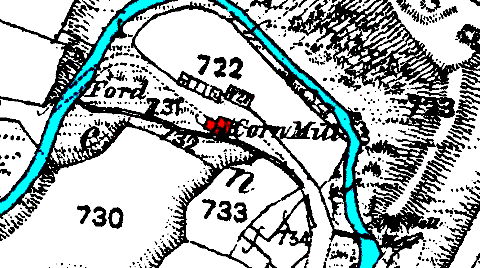(160) Glen Mooar Mill

From 1868 O/S Plan - SC 305894
Glen Mooar is south of Glen Wyllin
- the plan predates the construction of the viaduct of the Manx
Northern Railway that crossed the glen on the seaward side of the
Peel to Kirk Michael road shown right hand bottom corner..
|

The Manx Museum holds an unattributed (+ somewhat amateur) painting
titled Cannell's mill - the site shown matches very well, but the badly
shown wheel feed arrangement doesn't fit that implied by the O/S plan..
|
Kissack argues that the earliest mentioned mill in Michael was actually in
Glen Mooar - the waterfall towards the end of this glen being an obvious location
to site a mill though the poor access might have contributed a later mill in
Glen Wyllin becoming more important.
Dunbar in his account
of internment during WW1 at Douglas describes a visit to the "dilapidated
mill, which he [Dr Marshall] had procured for himself in the north of the island
and was now in the process of having transformed into a country house by ten
prisoners under the guidance of Herr Kallenbach, who is an architect".
The visit started with a railway trip to Kirk Michael then a walk along the
road after which "we came to a waterfall, which had earlier powered the
mill-wheel. In the dilapidated house, we first made ourselves breakfast, then
the men set about their work, and Herr von Beyerheim and myself walked down
to the sea." which description aptly describes Glen Mooar Mill - the site
of which is now a house.
Registered Deed Nov 1849 #11 would appear to relate to this mill
[cancelled]dated 26 Oct 1849;Recites William Quayle(blacksmith) died having
made a jt will with wife Catherine
(dated 4 Nov 1846) which empowered her to raise a mortgage on property thus
she now stands indebted for £80 to John Cain(cooper, Kk Michael) and
gave as security their dwelling house, dye house, mill and premises near Ballagawne
in the parish of Michael; Witt John Cannell, Richard Hutchinson (Cath Quayle
'x'); redeemed 26 Dec 1851 - John Caine(Michael) who notes the sd premises
sold by Public auction by Daniel Kelly (Coroner) to John Quayle(blacksmith,
Michael) acks fully repaid by sd John Quayle [?reg deed Dec 1860 #14]
William Quayle in his 1846 will describes Ivy house as the new house suggesting
it was newlly built and bequeathed it to his son Thomas Quayle. Registered deed
Dec 1860 #14 gives the next transfer to son John Quayle it is possible that
the new house and dye house were separate from the Mill being the two buildings
in field 722 - one of these is now a very attractive bungalow.
dated 4 Jul 1850;recites executions against Thomas Quayle and the dwelling
house, dye mill and premises at Ballaleigh in the parish of Michael adj the
high road on SE were put up for auction by Daniel Kelly (coroner) at which
John Quayle's bid of 6s was the highest (there was a mortgage of £80
to pay); Witt William Corlett, Robert Barton
The following history is described in Registered deed Dec 1885 #12
dated 28 Nov 1885;Mrs Martha Croft(widow, Cronk Urleigh Kk Michael) sells
for £175 to John Taylor(Newcroft house, Urmston Manchester) that Dwelling
house, mill and premises known as Ivy House together with 2 fields pt of Ballagawn
or Balla Killey Clieu one adg sd dwelling & other on opposite side of
highroad - all purchased by Wm Croft (decd husband) from John Quayle(Douglas
and formerly of Ivy house) by deed dated 19 Oct 1861, being dye house, carding
mill etc being part of Ballaleigh, in parish of Michael, bounded on north
by Philip Dougherty, on east by high road (Ramsey to Peel) and on south +
west by John Cannell; Witt Richard Ditchfield, Marianne Cannell
The description carding mill is much more fitting than corn mill as the approach
is via a very steep road dropping off the main highway and carding would suit
being combined with dyeing


